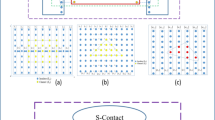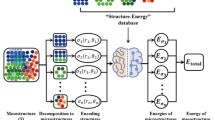Abstract
Data-driven machine learning has emerged to address the limitations of traditional methods when modeling interatomic interactions in materials, such as electronic density functional theory (DFT) and semi-empirical potentials. These machine-learning frameworks involve mathematical models coupled to quantum mechanical data. In the present article, we focus on the moment tensor potential (MTP) machine-learning framework. More specifically, we provide an account of the development of a preliminary MTP for silicon, including details pertaining to the construction of a DFT database.
Graphical abstract






Similar content being viewed by others
References
G. Hautier, C. Fischer, V. Ehrlacher, A. Jain, G. Ceder, Data mined ionic substitutions for the discovery of new compounds. Inorg. Chem. 50(2), 656–663 (2011)
Y. Liu, T. Zhao, J. Wangwei, S. Shi, Materials discovery and design using machine learning. J. Materiomics 3(3), 159–177 (2017)
E.V. Podryabinkin, E.V. Tikhonov, A.V. Shapeev, A.R. Oganov, Accelerating crystal structure prediction by machine-learning interatomic potentials with active learning. Phys. Rev. B 99(6), 064114 (2019)
Y.X. Zuo, C. Chen, X.G. Li, Z. Deng, Y.M. Chen, J. Behler, G. Csanyi, A.V. Shapeev, A.P. Thompson, M.A. Wood, Performance and cost assessment of machine learning interatomic potentials. J. Phys. Chem. A 124(4), 731–745 (2020)
J. Behler, M. Parrinello, Generalized neural-network representation of high-dimensional potential-energy surfaces. Phys. Rev. Lett. 98(14), 146401 (2007)
T. Mueller, A.G. Kusne, R. Ramprasad, Machine learning in materials science: Recent progress and emerging applications. Rev. Comput. Chem. 29, 186–273 (2016)
M. Mohri, A. Rostamizadeh, A. Talwalkar, Foundations of Machine Learning (MIT Press, Cambridge, 2018)
V. Botu, R. Batra, J. Chapman, R. Ramprasad, Machine learning force fields: construction, validation, and outlook. J. Phys. Chem. C 121(1), 511–522 (2017)
V.L. Deringer, M.A. Caro, G. Csányi, Machine learning interatomic potentials as emerging tools for materials science. Adv. Mater. 31(46), 1902765 (2019)
A.V. Shapeev, Moment tensor potentials: A class of systematically improvable interatomic potentials. Multiscale Model. Simul. 14(3), 1153–1173 (2016)
R. Ramprasad, R. Batra, G. Pilania, A. Mannodi-Kanakkithodi, C. Kim, Machine learning in materials informatics: Recent applications and prospects. npj Comput. Mater. 3(1), 1–13 (2017)
K. Gubaev, E.V. Podryabinkin, A.V. Shapeev, Machine learning of molecular properties: Locality and active learning. J. Chem. Phys. 148(24), 241727 (2018)
S. Zhao, E.N. Hahn, B. Kad, B.A. Remington, C.E. Wehrenberg, E.M. Bringa, M.A. Meyers, Amorphization and nanocrystallization of silicon under shock compression. Acta Mater. 103, 519–533 (2016)
K. Persson, Materials data on sio2 (sg:15) by materials project, 11 2014. An optional note
M.J. Mehl, D. Hicks, C. Toher, O. Levy, R.M. Hanson, G. Hart, S. Curtarolo, The aflow library of crystallographic prototypes: Part 1. Comput. Mater. Sci. 136, S1–S828 (2017)
D. Hicks, M.J. Mehl, E. Gossett, C. Toher, O. Levy, R.M. Hanson, G. Hart, S. Curtarolo, The aflow library of crystallographic prototypes: Part 2. Comput. Mater. Sci. 161, S1–S1011 (2019)
O.B. Gadzhiev, S.K. Ignatov, M.Y. Kulikov, A.M. Feigin, A.G. Razuvaev, P.G. Sennikov, O. Schrems, Structure, energy, and vibrational frequencies of oxygen allotropes o n (n 6) in the covalently bound and van der waals forms: Ab initio study at the ccsd (t) level. J. Chem. Theory Comput. 9(1), 247–262 (2013)
R.T. Downs, M. Hall-Wallace, The American mineralogist crystal structure database. Am. Miner. 88(1), 247–250 (2003)
H. Zheng, X.-G. Li, R. Tran, C. Chen, M. Horton, D. Winston, K.A. Persson, S.P. Ong, Grain boundary properties of elemental metals. Acta Mater. 186, 40–49 (2020)
R. Tran, X. Zihan, B. Radhakrishnan, D. Winston, W. Sun, K.A. Persson, S.P. Ong, Surface energies of elemental crystals. Sci. Data 3(1), 1–13 (2016)
B.-J. Lee, A modified embedded atom method interatomic potential for silicon. Calphad 31(1), 95–104 (2007)
C. Li, C. Wang, J. Han, L. Yan, B. Deng, X. Liu, A comprehensive study of the high-pressure-temperature phase diagram of silicon. J. Mater. Sci. 53(10), 7475–7485 (2018)
J. Crain, S.J. Clark, G.J. Ackland, M.C. Payne, V. Milman, P.D. Hatton, B.J. Reid, Theoretical study of high-density phases of covalent semiconductors. i. ab initio treatment. Phys. Rev. B 49(8), 5329 (1994)
M. De Jong, W. Chen, T. Angsten, A. Jain, R. Notestine, A. Gamst, M. Sluiter, C.K. Ande, S.V. Der Zwaag, J.J. Plata, Charting the complete elastic properties of inorganic crystalline compounds. Sci. Data 2(1), 1–13 (2015)
C. Freysoldt, B. Grabowski, T. Hickel, J. Neugebauer, G. Kresse, A. Janotti, C.G. Van de Walle, First-principles calculations for point defects in solids. Rev. Mod. Phys. 86(1), 253 (2014)
E. Clouet, Ab initio models of dislocations. Handbook of Materials Modeling: Methods: Theory and Modeling, pp. 1503–1524 (2020)
A. Goyal, Y. Li, A. Chernatynskiy, J.S. Jayashankar, M.C. Kautzky, S.B. Sinnott, S.R. Phillpot, The influence of alloying on the stacking fault energy of gold from density functional theory calculations. Comput. Mater. Sci. 188, 110236 (2021)
P.J.H. Denteneer, W. Van Haeringen, Stacking-fault energies in semiconductors from first-principles calculations. J. Phys. C 20(32), L883 (1987)
F.-Y. Tian, N.-X. Chen, L. Delczeg, L. Vitos, Interlayer potentials for fcc (1 1 1) planes of Pd–Ag random alloys. Comput. Mater. Sci. 63, 20–27 (2012)
W. Li, L. Song, H. Qing-Miao, S.K. Kwon, B. Johansson, L. Vitos, Generalized stacking fault energies of alloys. J. Phys. 26(26), 265005 (2014)
Y.-M. Juan, E. Kaxiras, Generalized stacking fault energy surfaces and dislocation properties of silicon: A first-principles theoretical study. Philos. Mag. A 74(6), 1367–1384 (1996)
W. Sun, G. Ceder, Efficient creation and convergence of surface slabs. Surf. Sci. 617, 53–59 (2013)
D. Sholl, J.A. Steckel, Density Functional Theory: A Practical Introduction (Wiley, Hoboken, 2011)
A. Ghoufi, P. Malfreyt, D.J. Tildesley, Computer modelling of the surface tension of the gas–liquid and liquid–liquid interface. Chem. Soc. Rev. 45(5), 1387–1409 (2016)
J.-C. Neyt, A. Wender, V. Lachet, P. Malfreyt, Prediction of the temperature dependence of the surface tension of so2, n2, o2, and ar by Monte Carlo molecular simulations. J. Phys. Chem. B 115(30), 9421–9430 (2011)
P. Geysermans, D. Gorse, V. Pontikis, Molecular dynamics study of the solid–liquid interface. J. Chem. Phys. 113(15), 6382–6389 (2000)
R. Šolc, M.H. Gerzabek, H. Lischka, D. Tunega, Wettability of kaolinite (001) surfaces-molecular dynamic study. Geoderma 169, 47–54 (2011)
G. Ulian, D. Moro, G. Valdrè, Dft simulation of the water molecule interaction with the (00l) surface of montmorillonite. Minerals 11(5), 501 (2021)
Z. Liang, W. Evans, P. Keblinski, Equilibrium and nonequilibrium molecular dynamics simulations of thermal conductance at solid–gas interfaces. Phys. Rev. E 87(2), 022119 (2013)
F.H. Stillinger, T.A. Weber, Computer simulation of local order in condensed phases of silicon. Phys. Rev. B 31(8), 5262 (1985)
J. Tersoff, New empirical approach for the structure and energy of covalent systems. Phys. Rev. B 37(12), 6991 (1988)
G.T. Barkema, N. Mousseau, High-quality continuous random networks. Phys. Rev. B 62(8), 4985 (2000)
V.L. Deringer, N. Bernstein, A.P. Bartók, M.J. Cliffe, R.N. Kerber, L.E. Marbella, C.P. Grey, S.R. Elliott, G. Csányi, Realistic atomistic structure of amorphous silicon from machine-learning-driven molecular dynamics. J Phys Chem Lett 9(11), 2879–2885 (2018)
P. Giannozzi, S. Baroni, N. Bonini, M. Calandra, R. Car, C. Cavazzoni, D. Ceresoli, G.L. Chiarotti, M. Cococcioni, I. Dabo, Quantum espresso: A modular and open-source software project for quantum simulations of materials. J. Phys. 21(39), 395502 (2009)
P.E. Blöchl, Projector augmented-wave method. Phys. Rev. B 50(24), 17953 (1994)
J.P. Perdew, K. Burke, M. Ernzerhof, Generalized gradient approximation made simple. Phys. Rev. Lett. 77(18), 3865 (1996)
H.J. Monkhorst, J.D. Pack, Special points for brillouin-zone integrations. Phys. Rev. B 13(12), 5188 (1976)
I.S. Novikov, K. Gubaev, E. Podryabinkin, A.V. Shapeev, The MLIP package: Moment tensor potentials with MPI and active learning. Mach. Learn. 2, 025002 (2020)
B. Mortazavi, E.V. Podryabinkin, S. Roche, T. Rabczuk, X. Zhuang, A.V. Shapeev, Machine-learning interatomic potentials enable first-principles multiscale modeling of lattice thermal conductivity in graphene/borophene heterostructures. Mater. Horiz. 7(9), 2359–2367 (2020)
A. Lomaka, T. Tamm, Linearization of moment tensor potentials for multicomponent systems with a preliminary assessment for short-range interaction energy in water dimer and trimer. J. Chem. Phys. 152(16), 164115 (2020)
I.S. Novikov, Y.V. Suleimanov, A.V. Shapeev, Automated calculation of thermal rate coefficients using ring polymer molecular dynamics and machine-learning interatomic potentials with active learning. Phys. Chem. Chem. Phys. 20(46), 29503–29512 (2018)
K. Gubaev, E.V. Podryabinkin, G.L.W. Hart, A.V. Shapeev, Accelerating high-throughput searches for new alloys with active learning of interatomic potentials. Comput. Mater. Sci. 156, 148–156 (2019)
I.I. Novoselov, A.V. Yanilkin, A.V. Shapeev, E.V. Podryabinkin, Moment tensor potentials as a promising tool to study diffusion processes. Comput. Mater. Sci. 164, 46–56 (2019)
K.T. Butler, D.W. Davies, H. Cartwright, O. Isayev, A. Walsh, Machine learning for molecular and materials science. Nature 559(7715), 547–555 (2018)
J.F. Cannon, Behavior of the elements at high pressures. J. Phys. Chem. Ref. Data 3(3), 781–824 (1974)
H. Jing Zhu, L.D. Merkle, C.S. Menoni, I.L. Spain, Crystal data for high-pressure phases of silicon. Phys. Rev. B 34(7), 4679 (1986)
K. Zongo, L. K Béland, C. Ouellet-Plamondon, Improving atom-scale models of clay minerals using machine learning. Can. Nuclear Soc. (2021)
A.P. Bartók, J. Kermode, N. Bernstein, G. Csányi, Machine learning a general-purpose interatomic potential for silicon. Phys. Rev. X 8(4), 041048 (2018)
G. Henkelman, B.P. Uberuaga, H. Jónsson, A climbing image nudged elastic band method for finding saddle points and minimum energy paths. J. Chem. Phys. 113(22), 9901–9904 (2000)
G.S. Hwang, W.A. Goddard III., Diffusion and dissociation of neutral divacancies in crystalline silicon. Phys. Rev. B 65(23), 233205 (2002)
D. YaojunA, S.A. Barr, K.R.A. Hazzard, T.J. Lenosky, R.G. Hennig, J.W. Wilkins, Fast diffusion mechanism of silicon tri-interstitial defects. Phys. Rev. B 72(24), 241306 (2005)
F. El-Mellouhi, N. Mousseau, P. Ordejón, Sampling the diffusion paths of a neutral vacancy in silicon with quantum mechanical calculations. Phys. Rev. B 70(20), 205202 (2004)
Acknowledgments
We thank Dr. Yaoting Zhang for insightful discussions. The authors wish to thank Compute Canada for generous allocation of computer resources, the Natural Sciences and Engineering Research Council of Canada (NSERC), and the Nuclear Waste Management Organization (NWMO) for financial support. There is no conflict of interest. Data will be made available upon request.
Author information
Authors and Affiliations
Corresponding author
Supplementary Information
Below is the link to the electronic supplementary material.
Rights and permissions
About this article
Cite this article
Zongo, K., Béland, L.K. & Ouellet-Plamondon, C. First-principles database for fitting a machine-learning silicon interatomic force field. MRS Advances 7, 39–47 (2022). https://doi.org/10.1557/s43580-022-00228-z
Received:
Accepted:
Published:
Issue Date:
DOI: https://doi.org/10.1557/s43580-022-00228-z




